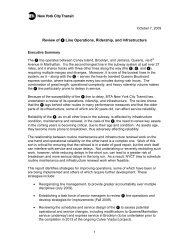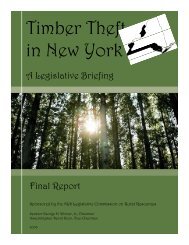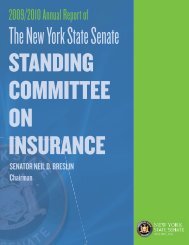Crime Committee Report e.indd - New York State Senate
Crime Committee Report e.indd - New York State Senate
Crime Committee Report e.indd - New York State Senate
Create successful ePaper yourself
Turn your PDF publications into a flip-book with our unique Google optimized e-Paper software.
the same weight with regard to the restoration of rights, are essential resources to support the<br />
employment of individuals with criminal histories, thereby promoting public safety and saving<br />
tax dollars. A person can only apply for one type of certificate. The eligibility for each depends<br />
on the person’s criminal record.<br />
Some statutes imposing statutory bars mistakenly reference only one of these certificates as<br />
lifting the bar or restoring rights. As a result individuals who are eligible only for the other certificate<br />
are forever arbitrarily barred from lifting the statutory bar. This bill makes conforming<br />
technical changes to various provisions of law that create statutory bars and correctly identifies<br />
both certificates of relief and certificates of good conduct as lifting such bars.<br />
S.2233-A<br />
Chapter 113 of the Laws of 2010<br />
MONTGOMERY, HASSELL-THOMPSON, KRUEGER<br />
Parental Rights & Prisoners - Reentry<br />
Signed into law by Governor Paterson, this law to amends the social services law to allow a<br />
foster care agency to delay the filing of a termination petition when the parent or parents are<br />
incarcerated or participating in a residential substance abuse treatment program, or when<br />
the prior incarceration or participation of a parent or parents in a residential substance abuse<br />
treatment program is a significant factor in why the child has been in care for 15 of the last<br />
22 months, provided that the parent maintains a meaningful role in the child’s life, and the<br />
agency has not documented a reason why it would otherwise be appropriate to file a petition.<br />
This legislation would also allow the court to consider the special circumstances of an incarcerated<br />
parent or a parent in a residential substance abuse treatment program in determining<br />
whether a child is a “permanently neglected child” as defined in the social services law. The bill<br />
also would amend the social services law to allow the court to consider the circumstances of an incarcerated<br />
parent or a parent in a residential substance abuse treatment program when determining<br />
whether such parent has failed to keep the social service agency apprised of their location.<br />
Additionally, the bill would amend the social services law to require social services agencies<br />
to provide parents who are incarcerated or in a residential substance abuse treatment program<br />
with information about and referrals to rehabilitative services available to such parent to aid in<br />
the development of a meaningful relationship between such parent and the child. Finally, the<br />
bill amends the social service law to allow meetings to create and review family service plans to<br />
be done through the use of technology, including video-conference and teleconference technology,<br />
where an in-person meeting is impracticable.<br />
S.1290-A<br />
Chapter 411 of the Laws of 2009<br />
MONTGOMERY, ADAMS, BRESLIN, DIAZ, DILAN, DUANE, HASSELL-THOMPSON,<br />
KRUEGER, PARKER, SAVINO, SCHNEIDERMAN, STAVISKY /A 3373-A Perry<br />
Anti-Shackling of Women Giving Birth<br />
Signed into law by Governor Paterson, this legislation amends the Correction Law to restrict<br />
the use of restraints in situations in which a pregnant female inmate is being transported to a<br />
medical facility for the purpose of giving birth, and during delivery and recovery. The new law<br />
prohibits the use of mechanical restraints such as handcuffs, leg restraints and wrist restraints<br />
on inmates during labor and delivery. However, during extraordinary circumstances, when<br />
it is necessary to prevent an inmate from injuring herself, medical or correction personnel,<br />
the inmate may be handcuffed by one wrist. This legislation passed the <strong>New</strong> <strong>York</strong> <strong>State</strong> <strong>Senate</strong><br />
unanimously.<br />
Standing <strong>Committee</strong> on <strong>Crime</strong> Victims, <strong>Crime</strong> and Correction | 2009-2010 <strong>Report</strong> 45









![[PDF] Proposed MTA Capital Program - New York State Senate](https://img.yumpu.com/24854139/1/190x245/pdf-proposed-mta-capital-program-new-york-state-senate.jpg?quality=85)






